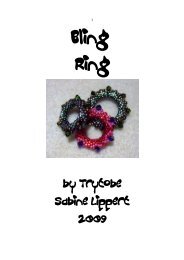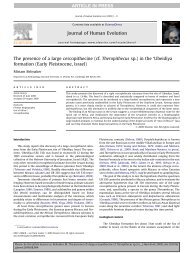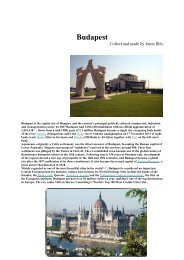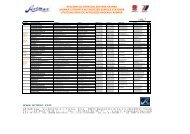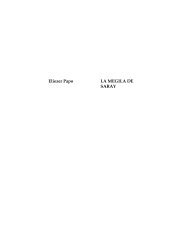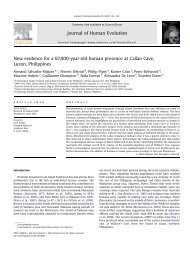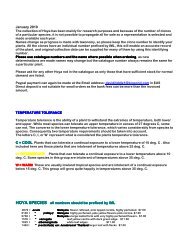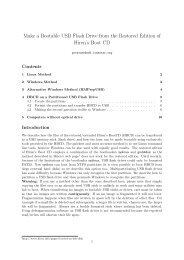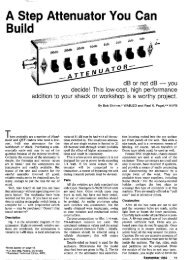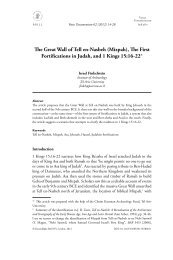Creativity, primordial cognition, and personality
Creativity, primordial cognition, and personality
Creativity, primordial cognition, and personality
You also want an ePaper? Increase the reach of your titles
YUMPU automatically turns print PDFs into web optimized ePapers that Google loves.
Abstract<br />
<strong>Creativity</strong>, <strong>primordial</strong> <strong>cognition</strong>, <strong>and</strong> <strong>personality</strong><br />
Colin Martindale *<br />
University of Maine, 4111 North Drinkwater Boulevard, Apartment B406, Scottsdale, AZ 85251, USA<br />
Received 23 December 2006; received in revised form 6 May 2007; accepted 29 May 2007<br />
Available online 12 July 2007<br />
Potential creativity measured by the Alternate Uses Test, remoteness of word associations, <strong>and</strong> rated creativity<br />
of fantasy stories was found to be related to <strong>primordial</strong> content in the fantasy stories. Psychoticism<br />
<strong>and</strong> extraversion have been found to be related to creativity. There are theoretical reasons to think that they<br />
might also be related to use of <strong>primordial</strong> <strong>cognition</strong>. Potential creativity <strong>and</strong> <strong>primordial</strong> content were correlated<br />
with both extraversion <strong>and</strong> psychoticism. Potential creativity <strong>and</strong> <strong>primordial</strong> <strong>cognition</strong> were much<br />
more strongly related to extraversion than to psychoticism. The common trait binding these traits together<br />
may be disinhibition. Relationships among creativity, <strong>primordial</strong> <strong>cognition</strong>, <strong>and</strong> extraversion are much<br />
stronger among men than among women.<br />
Ó 2007 Elsevier Ltd. All rights reserved.<br />
Keywords: <strong>Creativity</strong>; Disinhibition; Extraversion; Primordial <strong>cognition</strong>; Psychoticism<br />
1. Introduction<br />
Martindale (1971) noted that well over half of the terms that highly creative people use to<br />
describe themselves involve both cognitive <strong>and</strong> behavioral disinhibition <strong>and</strong> lack of control.<br />
The reason for the article was to point out that this was not a newly discovered relationship<br />
but a relationship perfectly well known to Lombroso (1895) <strong>and</strong> other 19th-century scientists.<br />
* Tel.: +1 480 272 8292.<br />
E-mail address: cmartin61@cox.net<br />
Personality <strong>and</strong> Individual Differences 43 (2007) 1777–1785<br />
0191-8869/$ - see front matter Ó 2007 Elsevier Ltd. All rights reserved.<br />
doi:10.1016/j.paid.2007.05.014<br />
www.elsevier.com/locate/paid
1778 C. Martindale / Personality <strong>and</strong> Individual Differences 43 (2007) 1777–1785<br />
The purpose of the present article is to shed more light on the relationship rather than to deal with<br />
when it was first noticed.<br />
Although creativity involves a lot of very hard work, it is interesting that creative geniuses are<br />
virtually unanimous in their opinion that creative inspiration itself is effortless <strong>and</strong> not under conscious<br />
control (Ghiselin, 1985). It tends to occur in states of reverie in which <strong>cognition</strong> is disinhibited<br />
in the sense of not being hierarchically organized or guided by purpose or design.<br />
When analyzed, creative ideas are found to be novel combinations of old ideas previously<br />
thought to be unrelated. Martindale (1981, 1995, 1999) showed, when expressed in terms of a<br />
neural-network framework, that all plausible theories of creativity are almost identical but merely<br />
expressed in quite different vocabularies. It is generally agreed that consciousness or states of mind<br />
vary along a continuum ranging from ordinary, wakeful, reality-oriented, rational, problem-solving,<br />
conceptual <strong>cognition</strong>, through several types of fantasy <strong>and</strong> reverie to dreaming. The further<br />
one gets from waking problem solving <strong>cognition</strong>, the more thinking becomes irrational, free associative,<br />
unconcerned with purpose or problem solving, <strong>and</strong> dominated by concrete images rather<br />
than abstract concepts. Attention is narrowly focused in conceptual states. It becomes increasingly<br />
defocused as we move toward <strong>primordial</strong> <strong>cognition</strong>. Theorists as diverse as Berlyne<br />
(1965), Freud (1900), Nietzsche (1872), Werner (1948), <strong>and</strong> Wundt (1896) have given this continuum<br />
various names. For want of a better term, I refer to it as the conceptual-<strong>primordial</strong> <strong>cognition</strong><br />
continuum. (In some earlier publications, I used the terms secondary process-primary process, but<br />
this caused confusion, as readers thought that I was embracing Freudian theory rather than just<br />
using the terms in a descriptive manner.)<br />
In order to increase the probability of having a creative idea, one must regress from conceptual<br />
toward <strong>primordial</strong> <strong>cognition</strong>. This works only up to a point, however. The probability of having a<br />
creative idea is related in an inverted-U fashion to the degree that <strong>cognition</strong> is <strong>primordial</strong> in nature.<br />
Extremely <strong>primordial</strong> <strong>cognition</strong> is too diffuse <strong>and</strong> holophrastic to yield creative ideas. Thus,<br />
creative ideas usually arise from states of reverie <strong>and</strong> virtually never from dreams (Martindale,<br />
1995).<br />
In extremely conceptual <strong>cognition</strong>, ideas may be compared to atoms in a crystal. The atoms<br />
(ideas) are precisely fixed in place in extremely conceptual <strong>cognition</strong>, so that a new combination<br />
is completely impossible. If we heat the crystal, it will turn into a liquid, <strong>and</strong> the bonds amongst<br />
atoms will loosen. The probability that two remote atoms will combine with each other is<br />
increased. This is analogous to a movement toward more <strong>primordial</strong> <strong>cognition</strong>. This movement<br />
increases the probability that remotely associated ideas will be combined. If we apply even more<br />
heat, our liquid will eventually become a gas. Now virtually any atom (word, image, or idea) may<br />
combine with any other. This corresponds to a state of extreme <strong>primordial</strong> <strong>cognition</strong>. On the mental<br />
level, it leads not to novelty but to nonsense, as the ideas combined will be r<strong>and</strong>omly related. In<br />
neural-network terms, conceptual <strong>cognition</strong> <strong>and</strong> focused attention correspond to a situation in<br />
which a very small number of nodes representing ideas, words, or images are very highly activated.<br />
On the other h<strong>and</strong>, <strong>primordial</strong> <strong>cognition</strong> <strong>and</strong> defocused attention may be modeled as a<br />
state in which a large number of nodes are activated but to a slight degree. This of course increases<br />
the probability of noticing a novel combination if the nodes are activated sufficiently to enter<br />
consciousness.<br />
Once one has had a creative idea, one must do something with it. It is necessary to move to a<br />
state of conceptual <strong>cognition</strong> in order to verify or elaborate the new idea. If one is a scientist,
C. Martindale / Personality <strong>and</strong> Individual Differences 43 (2007) 1777–1785 1779<br />
experiments must be done <strong>and</strong> the resultant data analyzed. If one is a poet, the original inspiration<br />
must be cast into a form following the style in which one is writing, <strong>and</strong> so on. Clearly, these tasks<br />
require conceptual thinking <strong>and</strong> focused attention. Thus, the general theory is that creative people<br />
show more variability along the <strong>primordial</strong>–conceptual axis than do uncreative people. They can<br />
engage in <strong>primordial</strong> <strong>cognition</strong> in order to think of new ideas <strong>and</strong> in conceptual <strong>cognition</strong> in order<br />
to do something useful with the ideas.<br />
The theory outlined above is very similar to, <strong>and</strong> was initially derived from a theory first proposed<br />
by the psychoanalytic theorist Ernst Kris (1952). He argued that creative people are more<br />
able to shift between primary process <strong>and</strong> secondary process modes of thinking than are uncreative<br />
people. According to Kris’ theory, creative inspiration involves regression to a primary<br />
process state of consciousness. The elaboration or verification stage of the creative process involves<br />
a return to a secondary process state. Because uncreative people are less mobile along<br />
the primary process–secondary process continuum, they are unable to think of creative ideas.<br />
Kris also argued that creative people have the ability to use primary process <strong>cognition</strong> on neutral<br />
material, whereas the uncreative use it on personally relevant material. One might say that<br />
creative people have fantasies <strong>and</strong> reveries about things such as prime numbers whereas the less<br />
creative have fantasies <strong>and</strong> reveries only about parties, sex, <strong>and</strong> the like. The only differences<br />
between the <strong>primordial</strong>–conceptual continuum <strong>and</strong> Kris’s primary process–secondary process<br />
continuum is that the former is a more general concept (e.g., it includes traits such as focus<br />
of attention that are not mentioned by Kris) <strong>and</strong> is used in a purely descriptive way. On the<br />
other h<strong>and</strong>, Kris’s continuum is more narrowly defined <strong>and</strong> is explained in a psychoanalytic<br />
fashion. On the theoretical level, I argue that creativity is an inverted-U function of <strong>primordial</strong><br />
<strong>cognition</strong>, whereas Kris does not make this argument in regard to primary process <strong>cognition</strong>.<br />
Another difference is that Kris does not relate creativity to <strong>personality</strong>, but I (e.g., Martindale,<br />
1989) have argued that it requires the presence of <strong>personality</strong> traits most of which have to do<br />
with disinhibition. <strong>Creativity</strong> has often been found to be related to extraversion not because creative<br />
people are more sociable but because they are more disinhibited (Martindale, 1989). Both<br />
sociability <strong>and</strong> disinhibition are measured by most scales tapping extraversion. By the same token,<br />
creativity is often found to be related to psychoticism, which is measured by a scale containing<br />
a number of items tapping disinhibition.<br />
Several lines of evidence are supportive of the hypothesis that creativity <strong>and</strong> <strong>primordial</strong> <strong>cognition</strong><br />
are related. Creative people report engaging in more fantasy (Lynn & Rhue, 1986),<br />
remember their nighttime dreams better (Hudson, 1975), <strong>and</strong> are more easily hypnotized<br />
(Lynn & Rhue, 1986) than uncreative people. Creative people show more evidence of synesthesia<br />
<strong>and</strong> physiognomic perception (Dailey, Martindale, & Borkum, 1997), two aspects of <strong>primordial</strong><br />
states of mind, than do uncreative people. Martindale <strong>and</strong> Dailey (1996) found direct<br />
evidence for a relationship between <strong>primordial</strong> content <strong>and</strong> creativity in imaginative fantasy<br />
stories.<br />
The purpose of the research reported upon in this article was to investigate the relationships<br />
among creativity, <strong>primordial</strong> thinking, <strong>and</strong> <strong>personality</strong>. In a preliminary study, Martindale <strong>and</strong><br />
Dailey (1996) found significant relationships between creativity <strong>and</strong> <strong>primordial</strong> <strong>cognition</strong>.<br />
Though in the predicted direction, neither was significantly related to psychoticism. Both,<br />
though, were significantly related to extraversion. However, the study involved a small number<br />
of participants.
1780 C. Martindale / Personality <strong>and</strong> Individual Differences 43 (2007) 1777–1785<br />
2. Method<br />
2.1. Participants<br />
Participants were 50 male <strong>and</strong> 50 female undergraduate students enrolled in introductory<br />
psychology classes at the University of Maine. They received partial course credit for participation<br />
in the experiment. Their mean age was 18.7, SD = 1.2.<br />
2.2. Measures<br />
Primordial content was measured using the Regressive Imagery Dictionary (Martindale, 1975,<br />
1990) as applied by COUNT (Martindale, 1973) to machine-readable versions of stories written<br />
by participants in response to the topic: ‘‘A man <strong>and</strong> woman meet <strong>and</strong> go out on a date. Tell what<br />
led up to this, what the characters do, what they are thinking <strong>and</strong> feeling, <strong>and</strong> what happens<br />
afterwards’’.<br />
Martindale (1975) developed a computerized system of content analysis, the Regressive Imagery<br />
Dictionary, which measures the amount of <strong>primordial</strong> content in a text. The dictionary yields<br />
a <strong>primordial</strong> content score, which is the percentage of words in a verbal sample that fall into several<br />
<strong>primordial</strong> content categories. The categories are drives (references to oral, anal, <strong>and</strong> sexual<br />
content), sensations (references to raw sensations, as opposed to abstractions), perceptual disinhibition<br />
(references to disorder in the external world), regressive <strong>cognition</strong> (direct references to<br />
alteration in consciousness), <strong>and</strong> Icarian imagery (references to fire, water, rising, <strong>and</strong> falling –<br />
hypothetically, these are preverbal symbolization of motives <strong>and</strong> emotions). A conceptual content<br />
score – the percentage of words falling into categories tapping temporal references, moral imperatives,<br />
instrumental behavior, social behavior, abstraction, restraint, <strong>and</strong> order is also computed.<br />
The final <strong>primordial</strong> content score is obtained by subtracting the percentage of words falling into<br />
the conceptual content categories from the percentage of words falling into the direct measures of<br />
<strong>primordial</strong> content. These categories were constructed by searching the theoretical literature on<br />
<strong>primordial</strong> <strong>cognition</strong> for attributes of such thought that could be indicated by word usage. The<br />
assumption is that a person’s state of consciousness or type of thought will be reflected in language<br />
content so that the latter can be used to measure the former. The categories <strong>and</strong> examples<br />
of words contained in each category have been presented in Martindale (1975, 1990). The dictionary<br />
as a whole contains 2900 words. Factor analyses consistently yield one factor with the direct<br />
measures of <strong>primordial</strong> content loading highly on one end <strong>and</strong> the indirect measure loading highly<br />
on the other. Very occasionally, a second factor with an eigen value very close to 1.00 emerges, but<br />
examination of scree plots suggest that it be ignored.<br />
A number of studies supports the construct validity of this scoring scheme. Theoretically, more<br />
<strong>primordial</strong> content should be found in the verbal productions of children (Freud, 1900; Werner,<br />
1948), primitive people (Freud, 1913; Werner, 1948), individuals exhibiting symptoms of psychopathology<br />
(Freud, 1900), people under the influence of consciousness-altering drugs, <strong>and</strong> of hypnosis<br />
(Fromm, 1978), <strong>and</strong> people exhibiting a lot of right- as compared with left-hemisphere<br />
cortical activation (Hoppe, 1977; McLaughlin, 1978). The Regressive Imagery Dictionary has<br />
yielded results in conformity with each of these predictions in a series of 12 studies (see Martindale,<br />
1990, for descriptions <strong>and</strong> the original citations). Indirect evidence for construct validity has
come from a series of 16 studies in which the dictionary yielded trends in <strong>primordial</strong> content predicted<br />
by a theory of literary history developed by Martindale (1975, 1990) in studies of historical<br />
trends in British, French, <strong>and</strong> American poetry, American popular music lyrics, Beatles lyrics, an<br />
experimental simulation of literary history, <strong>and</strong> so on. Further evidence has come from seven<br />
studies derived from Jungian theory of trends within the content of literary narratives (Martindale,<br />
1990; Martindale & West, 2002) <strong>and</strong> of a study of co-occurrence of <strong>primordial</strong> content with<br />
Jungian archetypal figures (Martindale & Martindale, 2007).<br />
We do not have a single test that provides an adequate measure of potential creativity, so a<br />
composite measure was created. Creative potential was measured in three ways. First, with a<br />
version of the Alternative Uses Test (Christensen, Guilford, Merrifield, & Wilson, 1960) in which<br />
participants thought of as many uses as they could for a brick, a shoe, <strong>and</strong> a newspaper. The score<br />
was the total number of uses thought of for the three objects. It has worked well in a number of<br />
prior composite measures of creativity (Martindale, 1999). Second, participants were asked to give<br />
the first word that came to mind for each of the 100 words in the Palermo <strong>and</strong> Jenkins (1964)<br />
word association norms. A participant’s score was the sum of the ranks of his or her responses<br />
on the norms (in which the most frequent response is given a rank of 1 <strong>and</strong> so on). For responses<br />
not listed in the norms, the score was the highest rank in the norms + 1. Eysenck (1995) argues<br />
that remoteness of word associates is probably our best measure of creative potential. Third,<br />
the fantasy stories were rated on a 1–10 scale for creativity by a male undergraduate unfamiliar<br />
with the purposes of the study. <strong>Creativity</strong> was defined as being ‘‘novel <strong>and</strong> appropriate’’, with<br />
appropriateness defined as being ‘‘a story rather than, for example, a list of r<strong>and</strong>om words or<br />
numbers’’. To assess reliability, another undergraduate unfamiliar with the study rated a r<strong>and</strong>omly<br />
selected subset of 20 stories by men <strong>and</strong> by women. The three measures of creativity are<br />
well validated but measure different aspects of creativity, so they tend to be very slightly intercorrelated.<br />
The three creativity measures were st<strong>and</strong>ardized <strong>and</strong> added together to form a composite<br />
measure of potential creativity. Personality measures were obtained from the Eysenck Personality<br />
Questionnaire (Eysenck & Eysenck, 1991).<br />
2.3. Procedure<br />
Participants were tested in small group sessions. They were given 25 min in which to write their<br />
fantasy story. They were asked to be as imaginative <strong>and</strong> creative as possible <strong>and</strong> to keep writing<br />
during the entire 25 min. The Alternate Uses Test was then administered, with 3 min allowed for<br />
each of the three items. Participants were given 15 min for the word-association test. Finally,<br />
20 min were allowed for completion of the Eysenck Personality Questionnaire.<br />
3. Results <strong>and</strong> discussion<br />
C. Martindale / Personality <strong>and</strong> Individual Differences 43 (2007) 1777–1785 1781<br />
Results were analyzed separately for men <strong>and</strong> women as well as the group as a whole, as male<br />
<strong>and</strong> female results differed in several ways. For men, the fantasy stories consisted of an average of<br />
404.7 (SD = 120.2) words, an average of 10.18% (SD = 3.4) of which fell into the direct <strong>primordial</strong><br />
categories, <strong>and</strong> 8.98% (SD = 2.06) into the conceptual content categories, yielding a net<br />
<strong>primordial</strong> score of 1.2% (SD = 4.73). For women, the comparable numbers were 460.44
1782 C. Martindale / Personality <strong>and</strong> Individual Differences 43 (2007) 1777–1785<br />
(SD = 86.13) words, with an average of 9.55% (SD = 2.88) falling into the <strong>primordial</strong> categories,<br />
9.255% (SD = 1.69) into the conceptual categories, <strong>and</strong> a resultant net <strong>primordial</strong> score of .44%<br />
(SD = 4.13). Factor analyses showed the <strong>primordial</strong> categories loading on one end of the first<br />
unrotated factor <strong>and</strong> the conceptual categories loading on the opposite end. A scree plot suggested<br />
that a second factor, with an eigen value of barely over 1.00 be ignored. Thus, the measure<br />
of <strong>primordial</strong> content was behaving as it always has.<br />
The average Alternate Uses Test score was 29.28 (SD = 8.84). For men, the average number of<br />
uses given for a brick correlated .46 with the number of uses for a shoe <strong>and</strong> .55 with the number of<br />
uses given for a newspaper, whereas the number of uses given for a shoe correlated .53 with the<br />
number given for a newspaper. For women, the correlations were .79, .59 <strong>and</strong> .69, respectively. In<br />
all cases, p < .001. Though higher for women, the AUT was judged to have adequate internal<br />
consistency.<br />
The average Remoteness of Associations score was 1928.4 (SD = 679.2) for men <strong>and</strong> 1719.1<br />
(SD = 552.1) for women. To assess internal consistency, I correlated remoteness of association<br />
on the first 50 items <strong>and</strong> the last 50 items. For men, the correlation was .78, p < .001, whereas<br />
for women it was .31, p < .05.<br />
The average rated story creativity score was 5.18 (SD = 2.14) for men <strong>and</strong> 6.26 (SD = 1.83) for<br />
women. For stories rated by more than one rater, the correlation between the two raters was<br />
r(18) = .71, p < .001 for men <strong>and</strong> r(18) = .75, p < .001 for women. The three measures of potential<br />
creativity were in no case significantly related with one another. The highest correlation was .14<br />
between remoteness of associations <strong>and</strong> story creativity in men. Under the assumption that they<br />
were measuring independent aspects of potential creativity, they were st<strong>and</strong>ardized <strong>and</strong> added<br />
together to form a composite creativity index. For purposes of brevity, this is simply referred<br />
to as creativity below.<br />
Scores for the EPQ-R for men, women, <strong>and</strong> the total sample are shown, along with their correlations<br />
with creativity <strong>and</strong> <strong>primordial</strong> content, in Table 1. As is usually the case, women had<br />
lower psychoticiism scores than did men, t(98) = 3.22, p < .01. They also had considerably<br />
higher extraversion scores, t(98) = 4.27, p < .001. Men had higher neuroticism scores, t(98) =<br />
2.32, p < .05.<br />
The scores for extraversion <strong>and</strong> neuroticism were correlated for men: r(48) = .30, p < .05. For<br />
women, the lie scale was negatively correlated with neuroticism, r(48) = .33, p < .05. For the<br />
total group, the lie scale correlated negatively with extraversion, r(98) = .26, p < .01. Primordial<br />
content <strong>and</strong> creativity were correlated .37, p < .01 for men <strong>and</strong> .28, p < .05.<br />
For the male sample, results are essentially in conformity with expectations. As may be seen in<br />
Table 1, creativity was positively correlated with extraversion <strong>and</strong> psychoticism to about the same<br />
degree. However, <strong>primordial</strong> content was much more strongly related to extraversion than to<br />
psychoticism. As noted above, creativity <strong>and</strong> <strong>primordial</strong> <strong>cognition</strong> were positively related. The<br />
results closely replicate those of Martindale <strong>and</strong> Dailey (1996). If we take extraversion <strong>and</strong><br />
psychoticicism as proxy measures of disinhibition, the results are what we would expect from<br />
the theory presented in Section 1.<br />
For women, we do find a relationship between creativity <strong>and</strong> extraversion, but <strong>primordial</strong> content<br />
does not enter the picture. Though not predicted, the negative correlation between creativity<br />
<strong>and</strong> the Lie scale makes sense. I know of no study in which the Lie scale has shown a significant<br />
positive relationship with creativity. At first glance, it would seem that the theory presented in
Table 1<br />
EPQ-R scores for men, women, <strong>and</strong> total sample <strong>and</strong> correlations with measures of creativity <strong>and</strong> <strong>primordial</strong> content<br />
Group<br />
Score<br />
Men<br />
M SD <strong>Creativity</strong> Primordial content<br />
Psychoticism 5.36 2.67 .35 *<br />
.13 **<br />
Extraversion 14.54 3.80 .33 *<br />
Neuroticism 10.92 3.99 .10 .12<br />
Lie 5.82 3.08 .00 .27 **<br />
Women<br />
Psychoticism 3.78 2.21 .13 .08<br />
Extraversion 17.58 3.31 .28 *<br />
.08<br />
Neuroticism 12.68 3.57 .01 .11<br />
Lie 5.28 3.66 .33 *<br />
.06<br />
Total<br />
Psychoticism 4.57 2.56 .13 .20 *<br />
Extraversion 18.07 3.86 .56 ***<br />
Neuroticism 11.80 3.87 .16 .15<br />
Lie 5.55 3.37 .18 **<br />
.15<br />
* p < .05.<br />
** p < .10.<br />
*** p < .001.<br />
C. Martindale / Personality <strong>and</strong> Individual Differences 43 (2007) 1777–1785 1783<br />
Section 1 is much more applicable to men than to women. It would be nice to have a general theory<br />
of creativity applicable to everyone regardless of sex, but this may not be the reality. In this<br />
study, the women were as creative as men on all measures, but they seem to have made creative<br />
responses on a basis rather different than that of men.<br />
The results for the sample as a whole are not of much interest aside from the fact that they confirm<br />
that creativity <strong>and</strong> extraversion are strongly related.<br />
In order to get a better picture of how the variables are interacting, factor analyses of creativity,<br />
<strong>primordial</strong> content, <strong>and</strong> the four EPQ-R measures were done for men, women, <strong>and</strong> the entire sample.<br />
The resultant factor structures are shown in Table 2.<br />
The factor for men reflects what I had hoped to find for the study as a whole: creativity,<br />
<strong>primordial</strong> <strong>cognition</strong>, psychoticism, <strong>and</strong> extraversion are opposed to neuroticism <strong>and</strong> the Lie<br />
scale. For women, we obtain three factors rather than one factor. The first factor might be looked<br />
upon as a watered down version of the single factor found for men. It is unclear if the other two<br />
factors should be taken as peculiar to the women in this sample or if they can be generalized to<br />
women in general. If the latter, the factor suggests that psychoticism <strong>and</strong> <strong>primordial</strong> content are<br />
closely correlated in women but that this has nothing to do with creativity. The fairly high loading<br />
of neuroticism suggests that the relation may have to do with pathological thinking. The third factor<br />
suggests a negative rather than a positive relationship between extraversion <strong>and</strong> <strong>primordial</strong><br />
<strong>cognition</strong>. It is probably best not to make much of these results until they have been replicated<br />
on another sample, as they may reflect nothing more than peculiarities of the present sample of<br />
women.<br />
.49 ***<br />
.19
1784 C. Martindale / Personality <strong>and</strong> Individual Differences 43 (2007) 1777–1785<br />
Table 2<br />
Factor analyses of creativity, <strong>primordial</strong> content, <strong>and</strong> EPQ-R scales<br />
Score Group<br />
Factor<br />
Men Women Total<br />
I I II III I II III<br />
<strong>Creativity</strong> .62 .80 .46 .02 .72 .40 .20<br />
Primordial content .74 .30 .44 .76 .44 .57 .12<br />
Psychoticism .56 .55 .22 .02 .10 .71 .43<br />
Extraversion .77 .30 .60 .71 .78 .58 .66<br />
Neuroticism .36 .41 .74 .00 .12 .57 .66<br />
Lie scale .52 .75 .25 .05 .60 .10 .53<br />
Factor loadings on unrotated factors with eigen values greater than 1.<br />
The first factor for the total sample reflects the basic finding of the study: a positive relationship<br />
among creativity, extraversion, <strong>and</strong> <strong>primordial</strong> content. The second factor is difficult to interpret,<br />
<strong>and</strong> the third has to do mainly with the EPQ-R so need not concern us.<br />
The main findings of the study are that creativity is related closely to <strong>primordial</strong> content <strong>and</strong><br />
extraversion <strong>and</strong> less closely to psychoticism at least with college students. The pattern of results<br />
is similar to that found by Martindale <strong>and</strong> Dailey (1996). They do not contradict Eysenck (1995)<br />
theory that psychoticism is the basis of genius-level creativity but suggest that disinhibition rather<br />
than psychoticism per se may be the main <strong>personality</strong> correlate of creativity at least in the case of<br />
potential creativity in students.<br />
Martindale has argued that creativity is related to disinhibition on both the cognitive <strong>and</strong><br />
behavioral levels. Of course, both extraversion <strong>and</strong> psychoticism tap aspects of disinhibition. It<br />
is certainly possible that psychoticism may be more closely related to creativity in the case of<br />
real-life as opposed to potential creativity. Studies in which a strong relationship is found between<br />
creativity <strong>and</strong> psychoticism often involve participants who exhibit actual creative behavior. On<br />
the other h<strong>and</strong>, the studies that have found no relationship or a weak relationship have all used<br />
participants who show only potential creativity. The psychoticism scale contains some very extreme<br />
items, so most college students get low scores on it. This restricts range <strong>and</strong> makes it difficult<br />
to find correlations. Studies of creativity in college students have their place, but they are ill suited<br />
to study the relationship between creativity <strong>and</strong> psychoticism.<br />
References<br />
Berlyne, D. E. (1965). Structure <strong>and</strong> direction in thinking. New York: Wiley.<br />
Christensen, P. R., Guilford, J. P., Merrifield, P. R., & Wilson, R. C. (1960). Alternate uses. Beverly Hills: Sheridan<br />
Psychological Service.<br />
Dailey, A., Martindale, C., & Borkum, J. (1997). <strong>Creativity</strong>, synaesthesia, <strong>and</strong> physiognomic perception. <strong>Creativity</strong><br />
Research Journal, 10, 1–8.<br />
Eysenck, H. J. (1995). Genius: The natural history of creativity. Cambridge: Cambridge University Press.<br />
Eysenck, H. J., & Eysenck, S. B. G. (1991). Manual of the Eysenck Personality Scales. San Diego: EDITS.<br />
Freud, S. (1900). The interpretation of dreams (p. 1938). New York: R<strong>and</strong>om House.
C. Martindale / Personality <strong>and</strong> Individual Differences 43 (2007) 1777–1785 1785<br />
Freud, S. (1913). Totem <strong>and</strong> taboo. London: Penguin.<br />
Fromm, E. (1978). Primary <strong>and</strong> secondary process in waking <strong>and</strong> altered states of consciousness. Journal of Altered<br />
States of Consciousness, 4, 115–128.<br />
Ghiselin, B. (Ed.). (1985). The creative process: Reflections on the invention in the arts <strong>and</strong> sciences. Berkeley, CA:<br />
University of California Press.<br />
Hoppe, K. (1977). Split brains <strong>and</strong> psychoanalysis. Psychoanalytic Quarterly, 46, 220–244.<br />
Hudson, L. (1975). Human beings: The psychology of human experience. New York: Anchor.<br />
Kris, E. (1952). Psychoanalytic explorations in art. New York: International Universities Press.<br />
Lombroso, C. (1895). The man of genius. New York: Charles Scribner’s Sons.<br />
Lynn, S. J., & Rhue, J. W. (1986). The fantasy-prone person: Hypnosis, imagination, <strong>and</strong> creativity. Journal of<br />
Personality <strong>and</strong> Social Psychology, 51, 404–408.<br />
Martindale, C. (1971). Degeneration, disinhibition, <strong>and</strong> genius. Journal of the History of the Behavioral Sciences, 7,<br />
177–182.<br />
Martindale, C. (1973). COUNT: A PL/I program for content analysis of natural language. Behavioral Science, 18, 148.<br />
Martindale, C. (1975). Romantic progression: The psychology of literary history. Washington, DC: Hemisphere.<br />
Martindale, C. (1981). Cognition <strong>and</strong> consciousness. Homewood, IL: Dorsey.<br />
Martindale, C. (1989). Personality, situation, <strong>and</strong> creativity. In J. A. Glover, R. R. Ronning, & C. R. Reynolds (Eds.),<br />
H<strong>and</strong>book of creativity (pp. 211–232). New York: Plenum Press.<br />
Martindale, C. (1990). The clockwork muse: The predictability of artistic change. New York: Basic Books.<br />
Martindale, C. (1995). <strong>Creativity</strong> <strong>and</strong> connectionism. In S. Smith, T. Ward, & R. Finke (Eds.), The creative <strong>cognition</strong><br />
approach (pp. 249–268). Cambridge: MIT Press.<br />
Martindale, C. (1999). Biological bases of creativity. In R. J. Sternberg (Ed.), H<strong>and</strong>book of creativity (pp. 137–152).<br />
New York: Cambridge University Press.<br />
Martindale, C., & Dailey, A. (1996). <strong>Creativity</strong>, primary process <strong>cognition</strong>, <strong>and</strong> <strong>personality</strong>. Personality <strong>and</strong> Individual<br />
Differences, 20, 409–414.<br />
Martindale, A. E., & Martindale, C. (2007). Portrayal of women <strong>and</strong> Jungian anima figures in literature: Quantitative<br />
content analytic studies. In L. Dorfman, C. Martindale, & V. Petrov (Eds.), Aesthetics <strong>and</strong> innovation (pp. 212–233).<br />
Cambridge: Cambridge Scholars Press.<br />
Martindale, C., & West, A. N. (2002). Quantitative hermeneutics: Inferring the meanings of narratives from trends in<br />
content. In W. van Peer & M. Louwerse (Eds.), Thematics: Interdisciplinary studies (pp. 377–396). Amsterdam: John<br />
Benjamins.<br />
McLaughlin, J. T. (1978). Primary <strong>and</strong> secondary process in the context of cerebral hemispheric specialization.<br />
Psychoanalytic Quarterly, 47, 237–266.<br />
Nietzsche, F. (1872). The birth of tragedy from the spirit of music. In The philosophy of Nietzsche (pp. 1927). New York:<br />
Modern Library.<br />
Palermo, D. S., & Jenkins, J. J. (1964). Word association norms: Grade school through college. Minneapolis: University<br />
of Minnesota Press.<br />
Werner, H. (1948). Comparative psychology of mental development. New York: International Universities Press.<br />
Wundt, W. (1896). Lectures on human <strong>and</strong> animal psychology. New York: Macmillan.



